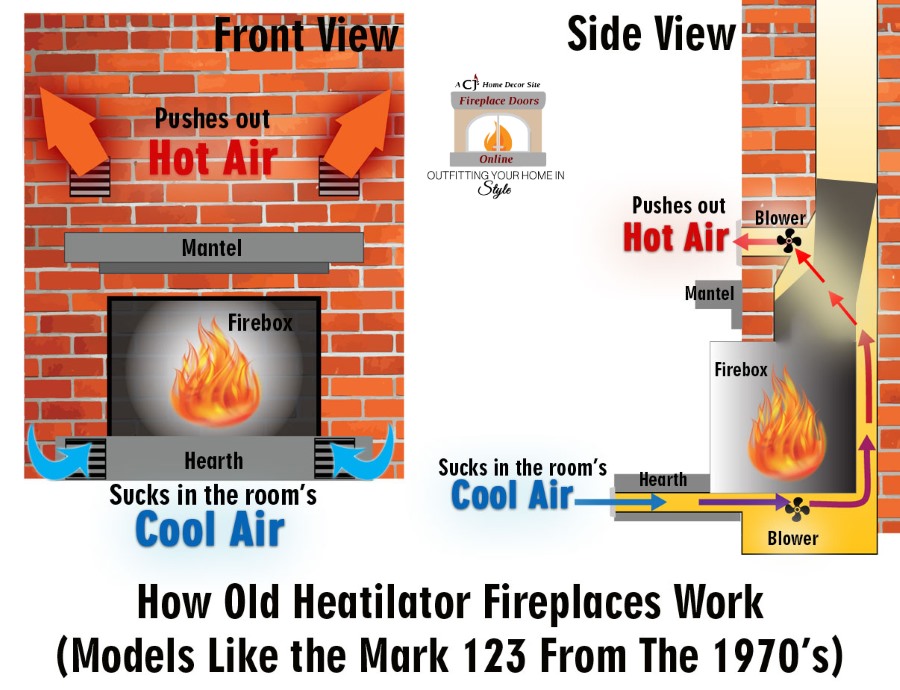How To Update Your Old Mark Series Heatilator Fireplace
 In 1968 Heatilator had the number one best selling masonry form fireplace on the market - the Mark 123 fireplace. At the time, these fireplaces were revolutionary in the way they helped you heat your room. And, chances are, if you have a home that was built in the 1970's and you haven't remodeled, then you probably have an old Mark Series Heatilator fireplace in your den, living room, or family room.
In 1968 Heatilator had the number one best selling masonry form fireplace on the market - the Mark 123 fireplace. At the time, these fireplaces were revolutionary in the way they helped you heat your room. And, chances are, if you have a home that was built in the 1970's and you haven't remodeled, then you probably have an old Mark Series Heatilator fireplace in your den, living room, or family room.
 If you've recently purchased a home that has one of the old Heatilators in it, you may have some confusion on how it works. Although it is a masonry fireplace, it has vents around it, that are somewhat like the louvers on a pre-fab fireplace. Your Mark 123 fireplace has blowers in it that bring the cool air of your room in through the bottom vents, push that air around the back of the hot firebox, and then push the now heated air out of the top vents. This air that is moved behind the fireplace is in a special chamber that is kept separate from the chimney, keeping all creosote and particulates out of the air that is pushed back into your room. As long as all of your blowers are working correctly, and you've taken decent care of your fireplace and chimney, your fireplace should continue to work well as it was intended.
If you've recently purchased a home that has one of the old Heatilators in it, you may have some confusion on how it works. Although it is a masonry fireplace, it has vents around it, that are somewhat like the louvers on a pre-fab fireplace. Your Mark 123 fireplace has blowers in it that bring the cool air of your room in through the bottom vents, push that air around the back of the hot firebox, and then push the now heated air out of the top vents. This air that is moved behind the fireplace is in a special chamber that is kept separate from the chimney, keeping all creosote and particulates out of the air that is pushed back into your room. As long as all of your blowers are working correctly, and you've taken decent care of your fireplace and chimney, your fireplace should continue to work well as it was intended.
Although they may not be as efficient as today's fireplaces, you don't necessarily need to rip out your old fireplace and replace it with a new one. In fact, we can give you some tips and tricks on how to simply update your Heatilator Mark 123 or Mark Series fireplace, without any major renovations.
 How to update your old Heatilator fireplace:
How to update your old Heatilator fireplace:
- Replace the fireplace door for a more modern look. All of our doors at Fireplace Doors Online are custom made, so creating a door to fit your old Heatilator Mark Series fireplace is what we do! By just changing out the aged, 1970's door with a newer one, your room gains style and your fireplace gains efficiency.
- Remove the doors from your fireplace, and install a fireplace insert inside your Mark 123. There are many different kinds of inserts - coal, biofuel, wood, and gas. An insert is much like a wood stove in the way that it produces heat, so this type of change would mean you'd heave much more heat produced. Chimney liner would need to be run in this case, as an insert requires pipe and not just the open chimney of the Heatilator Mark Series.
- If you do #2, you'll no longer need the vents at the bottom and top of the fireplace, so go all out and put a new facing on your fireplace!
No matter which way you go, know that Fireplace Doors Online is here to help you with any of your fireplace needs. We have many customers calling in about the old Heatilators, and wanted to make this information available for anyone who needs it.
No posts found



